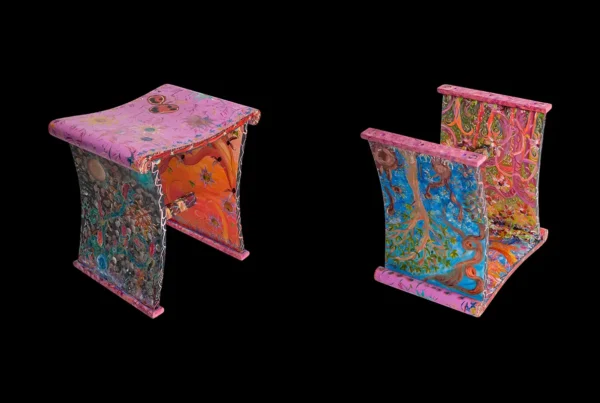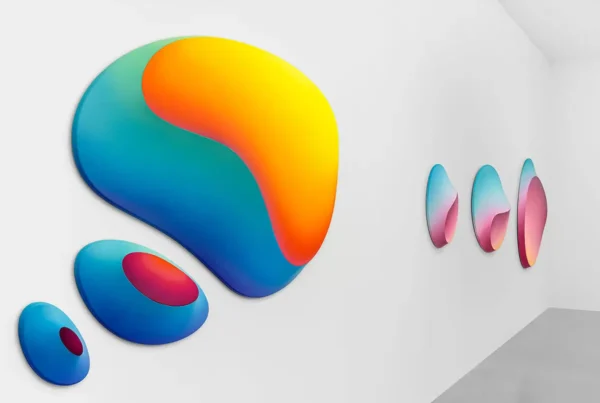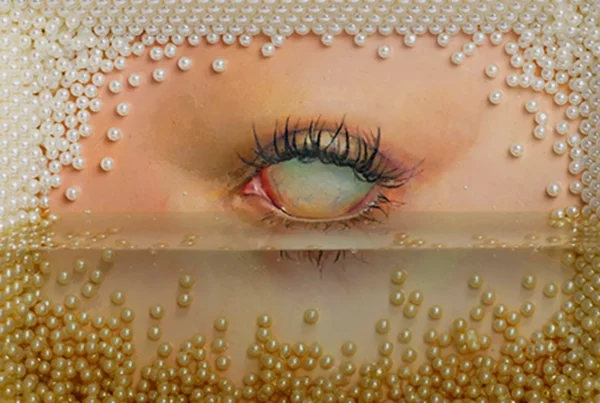“My pictures are flowing processes that actively challenge the viewer’s perception and invite them to reflect and engage with the multi-layered interpretations of reality.”
Shifting Realities: The Architecture of Thought
Fritz Oberleitner, born in 1962 in Graz, Austria, stands as a distinctive figure in contemporary painting, forging a path that bridges figuration, conceptual inquiry, and spatial innovation. Operating from his studio in Graz as a painter, inventor, and restorer, Oberleitner has developed a method of working that transcends the confines of conventional representation. Rather than offering static portrayals, his paintings unfold like cognitive maps, capturing the fleeting and fragmented nature of human perception. Each canvas becomes a living organism, inviting viewers into an intricate dialogue where reality and subjective interpretation constantly intertwine.
Central to Oberleitner’s practice is the examination of how the mind constructs and deconstructs the visible world. He crafts autonomous visual spaces using a unique perspective system of his own invention, free from classical spatial hierarchies. These paintings do not merely depict scenes; they reflect the elusive processes by which perception is filtered, distorted, and reassembled. With surfaces composed of acrylic, Plexiglas, and aluminum panels, he creates dynamic interactions of reflection, opacity, and movement, encouraging an active and continuous engagement from the viewer.
The layering of transparent glazes lends Oberleitner’s work a sense of perpetual transformation. Through this method, clarity and obscurity coexist, and the image remains suspended between appearance and disappearance. His commitment to this visual language has garnered international recognition, with exhibitions across Europe and beyond, including at institutions like Kunsthalle Graz and Boomer Gallery UK. His large-scale public works, such as Rotation from the Axis in Graz and Compression of a City in Gleisdorf, further explore these themes on a monumental scale, extending his inquiry into the perception of space into the urban environment.

Fritz Oberleitner: Emotional Geographies and Fragmented Realities
Oberleitner’s paintings are charged with emotional resonance and visual complexity, qualities he achieves through a careful manipulation of material and technique. Relying heavily on transparent acrylic glazing, he constructs surfaces where fragility and depth coexist, inviting viewers to experience the image as a shifting entity. This technique ensures that no reading of the painting remains final; rather, the work evolves with the viewer’s perspective, mirroring the mutable nature of perception itself. Through this approach, Oberleitner transforms the act of seeing into a participatory and psychological experience.
An undercurrent of darkness often permeates Oberleitner’s paintings, drawing influence from Japanese Edo culture and the Gothic textures of 19th-century European horror literature. This darkness is not simply aesthetic; it represents the unseen forces of memory, trauma, and existential uncertainty that lie beneath the surface of everyday experience. His works do not shy away from discomfort but instead create spaces where viewers must confront the complex and sometimes unsettling dimensions of their own inner worlds.
Fragmentation plays a pivotal role in how Oberleitner captures the lived experience. Rather than depicting scenes as cohesive wholes, he breaks them into mental shards — impulses of thought, emotion, and recollection. This method of visual construction mirrors the fractured nature of memory and consciousness. His paintings act as mirrors to the human condition, revealing how perception itself is an ever-shifting montage of incomplete moments, stitched together by the mind in a continuous attempt to make sense of an unstable world.

The Avatar, the Sphere, and the Fluidity of Space
A recurring element in Oberleitner’s work is the appearance of an avatar—a young woman who moves through various emotional and conceptual landscapes within his paintings. This figure serves not as a portrait of an individual but as a symbolic carrier of psychological states, cultural tensions, and existential inquiries. She embodies everything from ecstasy to trauma, functioning as a guide through the complex terrain Oberleitner constructs. Through her, viewers are given an emotional and intellectual anchor amid the swirling uncertainties of perception.
One of the most evocative metaphors Oberleitner employs is the sphere—a symbol for the mind’s perceptual space where inner and outer realities merge. Rather than envisioning perception as a linear process, he likens it to a spherical expansion in all directions, where thought and vision converge and blur. This concept aligns him with artists like Cezanne and Rubens, who also suggested space as a dynamic, curvilinear field rather than a flat plane. For Oberleitner, the sphere encapsulates the primal moment where sensation, memory, and imagination ignite into consciousness.
Departing from the fixed vanishing points of classical perspective, Oberleitner’s spatial constructions shift fluidly in response to mental movement. His example of seeing a woman on the beach, whose relaxed posture suddenly merged in his mind with the catastrophic image of a mushroom cloud, illustrates how external scenes are constantly reinterpreted by internal associations. In his paintings, space is not a stable container but an elastic field, shaped and reshaped by thought itself—a dynamic visualization of the mind at work.

Fritz Oberleitner: Painting Catastrophe and Memory
Oberleitner’s sensitivity to contemporary and historical trauma is poignantly reflected in specific works such as Rape of Europa in 2022. Sparked by the Russian invasion of Ukraine, the piece reinterprets Titian’s classical composition through a modern lens, fusing personal outrage with historical continuity. The painting becomes a site where ancient myths and present horrors collide, demonstrating Oberleitner’s ability to use traditional imagery to explore current global anxieties. By bridging centuries of artistic and political narrative, he amplifies the emotional charge of both the past and the present.
Pieces like I Saw Her Pain and The Horror of War further reveal Oberleitner’s commitment to creating emotionally charged spaces that resist easy interpretation. Although deeply personal, these paintings are not didactic. Rather than steering the viewer toward a specific emotional response, he constructs open fields where individuals can project their own feelings and memories. This openness ensures that each encounter with his work is deeply individual, shaped by the viewer’s own psychological and emotional history.
Oberleitner’s relationship to art history is rooted in respect and transformation. Classical notions of figuration, abstraction, and perspective are not discarded but reimagined to suit the fractured, fluid nature of 21st-century existence. In his hands, figuration becomes the expression of emotional essence rather than literal representation, while abstraction emerges as a method for revealing hidden truths. By bending these historical tools to new purposes, Fritz Oberleitner invites audiences into spaces where the visible world and the invisible workings of the mind become one continuous, shimmering field of exploration.






